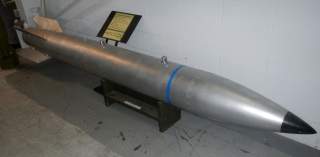Forget the MOAB the Air Force Dropped on ISIS. They Also Tested an (Inert) Nuclear Bomb.
Terrifying.
The B61-12 in fact is the latest variant of the B61 and will replace four versions of the nuclear bomb.
As reported by major media outlets, on Apr. 13, 2017 U.S. Air Force (USAF) Special Operations MC-130 dropped a GBU-43/B Massive Ordnance Air Blast (MOAB) bomb in Afghanistan to destroy an ISIS-K tunnel complex in Achin district, Nangarhar province at 19:32 local time.
Noteworthy this has been the first combat employment of the GBU-43/B.
On the same day a USAF news releaserevealed that on Mar. 14, 2017 an F-16from the 422nd Test and Evaluation Squadron at Nellis Test and Training Range Complex, Nevada, released an inert B61-12 nuclear bomb to demonstrate the aircraft’s capability to deliver the weapon and testing the functioning of the weapon’s non-nuclear components, including the arming and fire control system, radar altimeter, spin rocket motors and weapons control computer.
Noteworthy the test was conducted under a life-extension program for the B61, which is refurbishing both its nuclear and non-nuclear components to extend the bomb’s service life, while improving its safety, security and reliability.
The B61-12 in fact is the latest variant of the B61 and will replace four versions of the nuclear bomb.
“The B61-12 gravity bomb ensures the current capability for the air-delivered leg of the U.S. strategic nuclear triad well into the future for both bombers and dual-capable aircraft supporting NATO,” said Paul Waugh, Air Force Nuclear Weapons Center’s (AFNWC) Air-Delivered Capabilities director. The B61-12 will be compatible with the B-2A, B-21, F-15E, F-16C/D, F-16 MLU, F-35 and Tornado aircraft.
While Boeing under an AFNWC contract designed the B61-12 tail kit, Sandia National Laboratories and Los Alamos National Laboratory, as federally funded research and development centers operating under National Nuclear Security Administration (NNSA), developed and manufactured the non-nuclear bomb assembly used for the flight test.
About 200 personnel in AFNWC’s Air-Delivered Capabilities Directorate deliver, sustain and support air-delivered nuclear weapon systems. The directorate is headquartered at Kirtland AFB and oversees locations at Eglin AFB, Florida; Joint Base San Antonio, Texas; Ramstein AB, Germany; Robins AFB, Georgia; Tinker AFB, Oklahoma; and Wright-Patterson AFB, Ohio.
This article by Dario Leone originally appeared on The Aviation Geek Club in 2017.
Image: Wikimedia.

